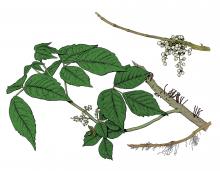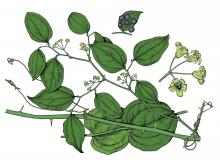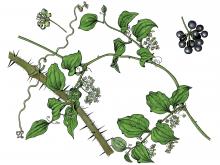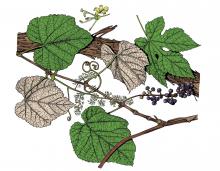Trees, Shrubs and Woody Vines
Media

Species Types
Scientific Name
Rhus aromatica
Description
Unlike its cousin poison ivy, fragrant sumac is a peasant, nontoxic plant. Note the middle leaflet of its "leaves of three": On fragrant sumac, there is no (or at most a very short) leaf stalk on that middle leaflet. Also, fragrant sumac has hairy, reddish fruits (not waxy whitish ones).
Media

Species Types
Scientific Name
Celastrus scandens
Description
American bittersweet is a native woody vine that climbs into trees or sprawls on bushes or fences. Its clusters of orange fruits split into sections to reveal seeds covered with a bright red, fleshy coating.
Media

Species Types
Scientific Name
Parthenocissus quinquefolia
Description
Occasionally confused with poison ivy, Virginia creeper is easily identified by simply noticing that most of its leaflets are in fives, instead of threes. This common native vine is useful in landscaping.
Media

Species Types
Scientific Name
Toxicodendron radicans
Description
Poison ivy is a toxic plant that contains an oil in all its parts that, if you come into contact with it, can cause an intense skin reaction. Learn to recognize it, and sidestep it on your outings.
Media

Species Types
Scientific Name
Parthenocissus vitacea (syn. P. inserta)
Description
Woodbine is a climbing woody vine that usually sprawls over bushes and rocks. Its leaves have five coarsely toothed leaflets. Unlike the closely related Virginia creeper, its tendrils generally lack sucker disks. It is rarely found in Missouri.
Media

Species Types
Scientific Name
Cissus trifoliata (syn. C. incisa)
Description
Marine vine is a climbing or trailing woody vine to 30 feet high, climbing by tendrils. Uncommon in Missouri, it is found only in our far southwestern counties.
Media

Species Types
Scientific Name
Smilax rotundifolia
Description
Round-leaved catbrier is a climbing, perennial woody vine to 20 feet long with tendrils and stout spines, sometimes forming tangled thickets. In Missouri, it is found mainly in the Bootheel and nearby southeastern Ozarks.
Media

Species Types
Scientific Name
Smilax hispida (syn. S. tamnoides var. hispida)
Description
Bristly greenbrier is a stout woody vine with bristlelike black spines, climbing high by tendrils to a length of 40 feet. It is the most common greenbrier in Missouri and is found statewide.
Media

Species Types
Scientific Name
Vitis palmata
Description
Red grape is an attractive, high-climbing, slender, delicate vine named for the color of its branches. It occurs mostly in eastern Missouri, especially along the Mississippi and Missouri rivers.
Media

Species Types
Scientific Name
Vitis aestivalis
Description
Summer grape is a vigorous, woody, wild grapevine climbing to a height of 35 feet. It grows mostly in the southern two-thirds of Missouri, often in drier situations than many other grape species.
See Also
About Trees, Shrubs and Woody Vines in Missouri
There are no sharp dividing lines between trees, shrubs, and woody vines, or even between woody and nonwoody plants. “Wood” is a type of tissue made of cellulose and lignin that many plants develop as they mature — whether they are “woody” or not. Trees are woody plants over 13 feet tall with a single trunk. Shrubs are less than 13 feet tall, with multiple stems. Vines require support or else sprawl over the ground.





















